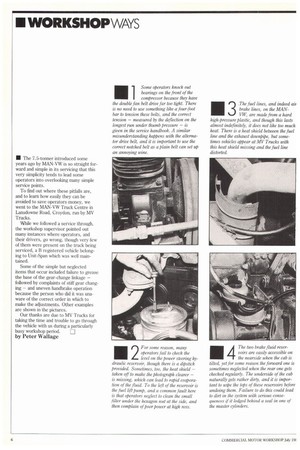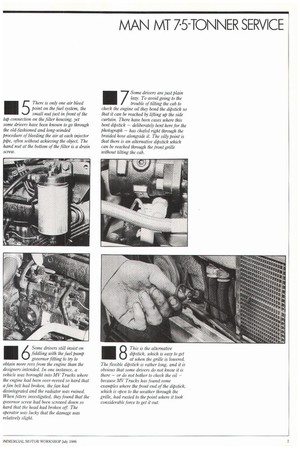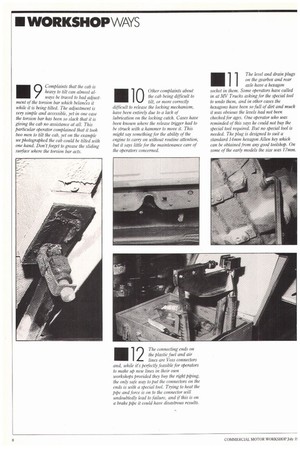• The 7.5-tonner introduced some years ago by MAN-VW is
Page 106

Page 107

Page 108

If you've noticed an error in this article please click here to report it so we can fix it.
so straight forward and simple in its servicing that this very simplicity tends to lead some operators into overlooking many simple service points.
To find out where these pitfalls are, and to learn how easily they can be avoided to save operators money, we went to the MAN-VW Truck Centre in Lansdowne Road, Croydon, run by MV Trucks.
While we followed a service through, the workshop supervisor pointed out many instances where operators, and their drivers, go wrong, though very few of them were present on the truck being serviced, a B registered vehicle belonging to Unit-Span which was well maintained.
Some of the simple but neglected items that occur included failure to grease the base of the gear-change linkage — followed by complaints of stiff gear changing — and uneven handbrake operation because the person who did it was unaware of the correct order in which to make the adjustments. Other examples are shown in the pictures.
Our thanks are due to MV Trucks for taking the time and trouble to go through the vehicle with us during a particularly busy workshop period.
by Peter Wallage 1 Some operators knock out bearings on the front of the compressor because they have the double fan belt drive far too tight. There is no need to use something like a four-foot bar to tension these bolts, and the correct tension — measured by the deflection on the longest run under thumb pressure — is given in the service handbook. A similar misunderstanding happens with the alternator drive belt, and it is important to use the correct notched belt as a plain belt can set up an annoying wine.
2 For some reason, many operators fail to check the level on the power steering hydraulic reservoir, though there is a dipstick provided. Sometimes, too, the heat shield — taken off to make the photograph clearer — is missing, which can lead to rapid evaporation of the fluid. To the left of the reservoir is the fuel lijft pump, and a common fault here is that operators neglect to clean the small filter under the hexagon nut at the side, and then complain of poor power at high revs. 3 The fuel lines, and indeed air brake lines, on the MANVW, are made from a hard high-pressure plastic, and though this lasts almost indefinitely, it does not like too much heat. There is a heat shield between the fuel line and the exhaust downpipe, but sometimes vehicles appear at MV Trucks with this heat shield missing and the fuel line distorted.
4 The two brake fluid reservoirs are easily accessible on the nearside when the cab is tilted, yet for some reason the forward one is sometimes neglected when the rear one gets checked regularly. The underside of the cab naturally gets rather dirty, and it is important to wipe the tops of these reservoirs before undoing them. Failure to do this could lead to dirt in the system with serious consequences if it lodged behind a seal in one of the master cylinders. SThere is only one air bleed point on the fuel system, the small nut just in front of the tap connection on the filter housing. yet some drivers have been known to go through the old-fashioned and long-winded procedure of bleeding the air at each injector pipe, often without achieving the object. The hand nut at the bottom of the filter is a drain screw.
6 Some drivers still insist on fiddling with the fuel pump governor fitting to try to obtain more revs from the engine than the designers intended. In one instance, a vehicle was borought into MV Trucks where the engine had been over-revved so hard that a fan belt had broken, the fan had disintegrated and the radiator was ruined. When fitters investigated, they found that the governor screw had been screwed down so hard that the head had broken off The operator was lucky that the damage was relatively slight. 7 Some drivers are just Plain lazy. To avoid going to the trouble of tilting the cab to check the engine oil they bend the dipstick so that it can be reached by lifting up the side curtain. There have been cases where this bent dipstick — deliberately bent here for the photograph — has chafed right through the braided hose alongside it. The silly point is that there is an alternative dipstick which can be reached through the front grille without tilting the cab.
8 This is th alternative dipstick, which is easy to get at when the grille is lowered. The flexible dipstick is rather long, and it is obvious that some drivers do not know it is there — or do not bother to check the oil — because MV Trucks has found some examples where the front end of the dipstick, which is open to the weather through the grille, had rusted to the point where it took considerable force to get it out. 9 Complaints that the cab is heavy to tilt can almost always be traced to bad adjustment of the torsion bar which belances it while it is being tilted. The adjustment i.s. very simple and accessible, yet in one case the torsion bar has been so slack that it is giving the cab no assistance at all. This particular operator complained that it took two men to tilt the cab, yet on the example we photographed the cab could be tilted with one hand. Don't forget to grease the sliding surface where the torsion bar acts. 1 the cab ar bcohmeipnlba:d.niftisicauboitutot tilt, or more correctly difficult to release the locking mechanism, have been entirely due to a lack of lubrication on the locking catch. Cases have been known where the release trigger had to be struck with a hammer to move it. This might say something for the ability of the engine to cariy on without routine attention, but it says little for the maintenance care of he operators concerned. 1 The level and drain plugs on the gearbox and rear axle have a hexagon socket in them. Some operators have called in at MV Trucks asking for the special tool to undo them, and in other cases the hexagons have been so full of dirt and muck it was obvious the levels had not been checked for ages. One operator who was reminded of this says he could not buy the special tool required. But no special tool is needed. The plug is designed to suit a standard 14mm hexagon Allen key which can be obtained from any good toolshop. On some of the early models the size was 17mm.
1 "ilh'heepclon ;:c;:e7ae:ddsafijrn lines are Voss connectors and, while it's perfectly feasible for operators to make up new lines in their own workshops provided they buy the right piping, the only safe way to put the connectors on the ends is with a special tool. Trying to heat the pipe and force is on to the connector will undoubtedly lead to failure, and if this is on a brake pipe it could have disastrous results.




















































































































